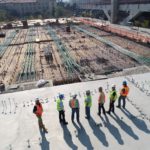Sector - Finance & Legislation
How the UK Can Learn from the Construction Sector

It’s anticipated that businesses will soon start to consider ways they will get their staff safely and responsibly back to work. If construction needs an example of a good working practice to adopt it themselves, then look no further than the construction sector, said Mark Wakeford, joint managing director of Stepnell.
When the UK went into lockdown, then so did thousands of British businesses. From micro companies and the self-employed, through to SMEs and large corporates. It goes without saying that every single British business has been affected by Covid-19.
Businesses were forced into hibernation and MDs had to create new ways of working – from setting up staff with technology to enable home working, to activating furlough to even ‘moth-balling’ their operations.
Now, the mood is changing. Company bosses – and workers – are voicing their need to get back to work in order to keeping their businesses alive, as well as the British economy, and working together to stave off a deep downturn.
As company leaders now begin to consider getting teams back into their workplaces in a never seen before scenario, it’s the construction sector they can look to for best practice.
So says Mark Wakeford, joint MD of construction firm Stepnell, a company which has complied with Government policy and remained on site throughout the lockdown, keeping its projects moving ahead, and staff employed.
“While other firms closed, we have been grappling for six weeks with new ways of working,” says Mark. “And yes, it has presented us challenges, but we have overcome most of them and if we can, then so can other firms.
“For contractors in the construction sector which decided to stop all activity, it will be harder for them as they prepare to get back to site and get quickly back up to speed.
“As well as contractors, many firms across the construction sector supply chain will be preparing in the same way. Some will be on the edge and will struggle, some firms will face insolvency – and some, hopefully the vast majority – will survive.”
Stepnell has furloughed some staff, but on most of its sites, the company has kept working – responsibly, safely and, crucially, to Public Health England guidelines.
“We have been working to the guidelines for weeks,” said Mark. “We have had to consider new ways of working for our staff and subcontractor partners to keep the site moving and keeping everyone safe. There are lessons here that our construction colleagues – and other sectors – can learn from as we slowly return to the workplace,” added Mark.
“We will be seeing other businesses in the industry – and companies across all sectors, looking to adopt safe ‘back to work’ practices. To help them get quickly back up to speed, they can take some of the lessons learned from the construction sector.”
The way Stepnell quickly adapted to the ‘new normal’ and continued to work on site was largely due to the way the company had traditionally and successfully managed its sites.
Mark said: “The way Stepnell successfully ran sites through the lockdown was through stringent planning. From the way you order materials to the way you carry out individual tasks on site – everything flows from the initial planning.
“We took the pandemic very seriously and started at the bottom and worked our way up. We carried out risk assessments for each activity on site just as we always do with our supply chain partners. Covid-19 and Public Health England Guidelines were just another element to consider on our ways of working. If you get the basics right and build on that, then everything else can work.
“We did this collaboratively with those who had to carry on working which meant that our staff were assured by our methods and keen to continue working. The mandate from our board was to find a safe system of work and if there was not a safe system, then the operation could not continue until one was found. We shared best practice across the company and we empowered our staff to work safely or not at all.”
Mark believes that the ‘bottom up’ approach, coupled with plenty of collaboration with suppliers and subcontractors is the way forward, whether in construction or elsewhere. Communication with internal with teams and individuals, as well as talking regularly to partners, clients and suppliers has also paid dividends in ensuring clear messages and understanding across all Stepnell stakeholders. Continuing to communicate is vital during this period and is something that all companies should be doing.
Construction, with its overt safety culture, has worked hard to solve many of the problems that Covid-19 has created, but there are solutions for those with imagination and a can-do attitude – something that construction excels at and something that others can learn from.
While Stepnell has tried to operate ‘business as usual,’ the impact of social distancing and complying with national guidelines has inevitably slowed down operations on site.
“It has presented challenges. For example, one of our sites has windows which we have been unable to fit for six weeks because we have yet to work out how to fit them safely with a two-metre distance rule in mind,” said Mark.
“We have decorators who are working individually when they would be in a team and we have carpet fitters who are carrying carpets into a room in pairs but who are laying them individually – in accordance with the Construction Leadership Council’s Site Operating Procedure.”
Of course, the Site Operating Procedure rules don’t just include what is happening on the building sites, but also into workers’ downtime. “We operate staggered eating times in the canteen,” said Mark. “We have rotas so that five are in the canteen and social distancing – rather than the usual 12. Many of our sites have reasonable access so we have been encouraging staff and subcontractors to use their bicycles or drive independently in cars.”
Mark is aware that these new procedures mean that site activities are taking longer. Coupled with a shortage of key materials, construction is more costly and ultimately, these costs will have to be absorbed. These costs could be significant and will be borne by main contractors and their tier one suppliers and this next phase will be crucial to make sure that everyone in the supply chain is as efficient as they possibly can be.
To find out more about Stepnell visit: www.stepnell.co.uk or join the conversation at @Stepnellltd
If you would like to read more like this, then please click here
Related Articles
More Finance & Legislation Features
- Construction workers face the highest risk of fatality
13 Aug 25
Construction workers face the highest risk of fatality, with one in two Brits saying HSE training is skipped due to time pressure.
- From trades to transformation: Practical growth for SME construction firms
25 Jul 25
Many SME construction firms struggle to overcome common growth barriers.
- How sustainability and innovation can help construction companies in limit financial loss
28 Oct 24
Construction businesses are facing many challenges to their bottom line at once, but utilising creative strategies to innovate can help mitigate losses while also committing






